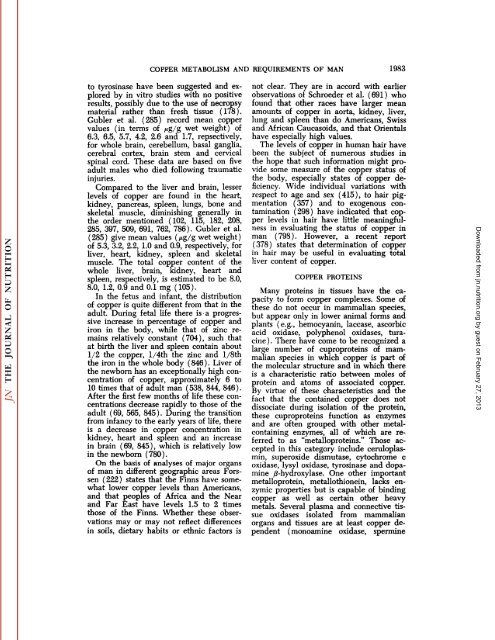conspectus of researchon copper metabolism and requirements
conspectus of researchon copper metabolism and requirements
conspectus of researchon copper metabolism and requirements
Create successful ePaper yourself
Turn your PDF publications into a flip-book with our unique Google optimized e-Paper software.
COPPER METABOLISM AND REQUIREMENTS OF MAN 1983<br />
to tyrosinase have been suggested <strong>and</strong> ex<br />
plored by in vitro studies with no positive<br />
results, possibly due to the use <strong>of</strong> necropsy<br />
material rather than fresh tissue (178).<br />
Gubler et al. (285) record mean <strong>copper</strong><br />
values (in terms <strong>of</strong> /*g/g wet weight) <strong>of</strong><br />
6.3, 6.5, 5.7, 4.2, 2.6 <strong>and</strong> 1.7, repsectively,<br />
for whole brain, cerebellum, basal ganglia,<br />
cerebral cortex, brain stem <strong>and</strong> cervical<br />
spinal cord. These data are based on five<br />
adult males who died following traumatic<br />
injuries.<br />
Compared to the liver <strong>and</strong> brain, lesser<br />
levels <strong>of</strong> <strong>copper</strong> are found in the heart,<br />
kidney, pancreas, spleen, lungs, bone <strong>and</strong><br />
skeletal muscle, diminishing generally in<br />
the order mentioned (102, 115, 182, 208,<br />
285, 397, 509, 691, 762, 786). Gubler et al.<br />
(285 ) give mean values (/¿g/gwet weight )<br />
<strong>of</strong> 5.3, 3.2, 2.2, 1.0 <strong>and</strong> 0.9, respectively, for<br />
liver, heart, kidney, spleen <strong>and</strong> skeletal<br />
muscle. The total <strong>copper</strong> content <strong>of</strong> the<br />
whole liver, brain, kidney, heart <strong>and</strong><br />
spleen, respectively, is estimated to be 8.0,<br />
8.0, 1.2, 0.9 <strong>and</strong> 0.1 mg (105).<br />
In the fetus <strong>and</strong> infant, the distribution<br />
<strong>of</strong> <strong>copper</strong> is quite different from that in the<br />
adult. During fetal life there is a progres<br />
sive increase in percentage <strong>of</strong> <strong>copper</strong> <strong>and</strong><br />
iron in the body, while that <strong>of</strong> zinc re<br />
mains relatively constant (704), such that<br />
at birth the liver <strong>and</strong> spleen contain about<br />
1/2 the <strong>copper</strong>, l/4th the zinc <strong>and</strong> l/8th<br />
the iron in the whole body (846). Liver <strong>of</strong><br />
the newborn has an exceptionally high con<br />
centration <strong>of</strong> <strong>copper</strong>, approximately 6 to<br />
10 times that <strong>of</strong> adult man (538, 844, 846).<br />
After the first few months <strong>of</strong> life these con<br />
centrations decrease rapidly to those <strong>of</strong> the<br />
adult (69, 565, 845). During the transition<br />
from infancy to the early years <strong>of</strong> life, there<br />
is a decrease in <strong>copper</strong> concentration in<br />
kidney, heart <strong>and</strong> spleen <strong>and</strong> an increase<br />
in brain (69, 845), which is relatively low<br />
in the newborn (780).<br />
On the basis <strong>of</strong> analyses <strong>of</strong> major organs<br />
<strong>of</strong> man in different geographic areas Forssen<br />
(222) states that the Finns have some<br />
what lower <strong>copper</strong> levels than Americans,<br />
<strong>and</strong> that peoples <strong>of</strong> Africa <strong>and</strong> the Near<br />
<strong>and</strong> Far East have levels 1.5 to 2 times<br />
those <strong>of</strong> the Finns. Whether these obser<br />
vations may or may not reflect differences<br />
in soils, dietary habits or ethnic factors is<br />
not clear. They are in accord with earlier<br />
observations <strong>of</strong> Schroeder et al. (691) who<br />
found that other races have larger mean<br />
amounts <strong>of</strong> <strong>copper</strong> in aorta, kidney, liver,<br />
lung <strong>and</strong> spleen than do Americans, Swiss<br />
<strong>and</strong> African Caucasoids, <strong>and</strong> that Orientals<br />
have especially high values.<br />
The levels <strong>of</strong> <strong>copper</strong> in human hair have<br />
been the subject <strong>of</strong> numerous studies in<br />
the hope that such information might pro<br />
vide some measure <strong>of</strong> the <strong>copper</strong> status <strong>of</strong><br />
the body, especially states <strong>of</strong> <strong>copper</strong> de<br />
ficiency. Wide individual variations with<br />
respect to age <strong>and</strong> sex (415), to hair pig<br />
mentation (357) <strong>and</strong> to exogenous con<br />
tamination (298) have indicated that cop<br />
per levels in hair have little meaningfulness<br />
in evaluating the status <strong>of</strong> <strong>copper</strong> in<br />
man (798). However, a recent report<br />
(378) states that determination <strong>of</strong> <strong>copper</strong><br />
in hair may be useful in evaluating total<br />
liver content <strong>of</strong> <strong>copper</strong>.<br />
COPPER PROTEINS<br />
Many proteins in tissues have the ca<br />
pacity to form <strong>copper</strong> complexes. Some <strong>of</strong><br />
these do not occur in mammalian species,<br />
but appear only in lower animal forms <strong>and</strong><br />
plants (e.g., hemocyanin, lacease, ascorbic<br />
acid oxidase, polyphenol oxidases, turacine).<br />
There have come to be recognized a<br />
large number <strong>of</strong> cuproproteins <strong>of</strong> mam<br />
malian species in which <strong>copper</strong> is part <strong>of</strong><br />
the molecular structure <strong>and</strong> in which there<br />
is a characteristic ratio between moles <strong>of</strong><br />
protein <strong>and</strong> atoms <strong>of</strong> associated <strong>copper</strong>.<br />
By virtue <strong>of</strong> these characteristics <strong>and</strong> the<br />
fact that the contained <strong>copper</strong> does not<br />
dissociate during isolation <strong>of</strong> the protein,<br />
these cuproproteins function as enzymes<br />
<strong>and</strong> are <strong>of</strong>ten grouped with other metalcontaining<br />
enzymes, all <strong>of</strong> which are re<br />
ferred to as "metalloproteins." Those ac<br />
cepted in this category include ceruloplasmin,<br />
Superoxide dismutase, cytochrome c<br />
oxidase, lysyl oxidase, tyrosinase <strong>and</strong> dopamine<br />
ß-hydroxylase. One other important<br />
metalloprotein, metallothionein, lacks enzymic<br />
properties but is capable <strong>of</strong> binding<br />
<strong>copper</strong> as well as certain other heavy<br />
metals. Several plasma <strong>and</strong> connective tis<br />
sue oxidases isolated from mammalian<br />
organs <strong>and</strong> tissues are at least <strong>copper</strong> de<br />
pendent (monoamine oxidase, spermine<br />
Downloaded from<br />
jn.nutrition.org<br />
by guest on February 27, 2013
















